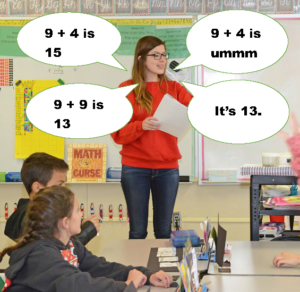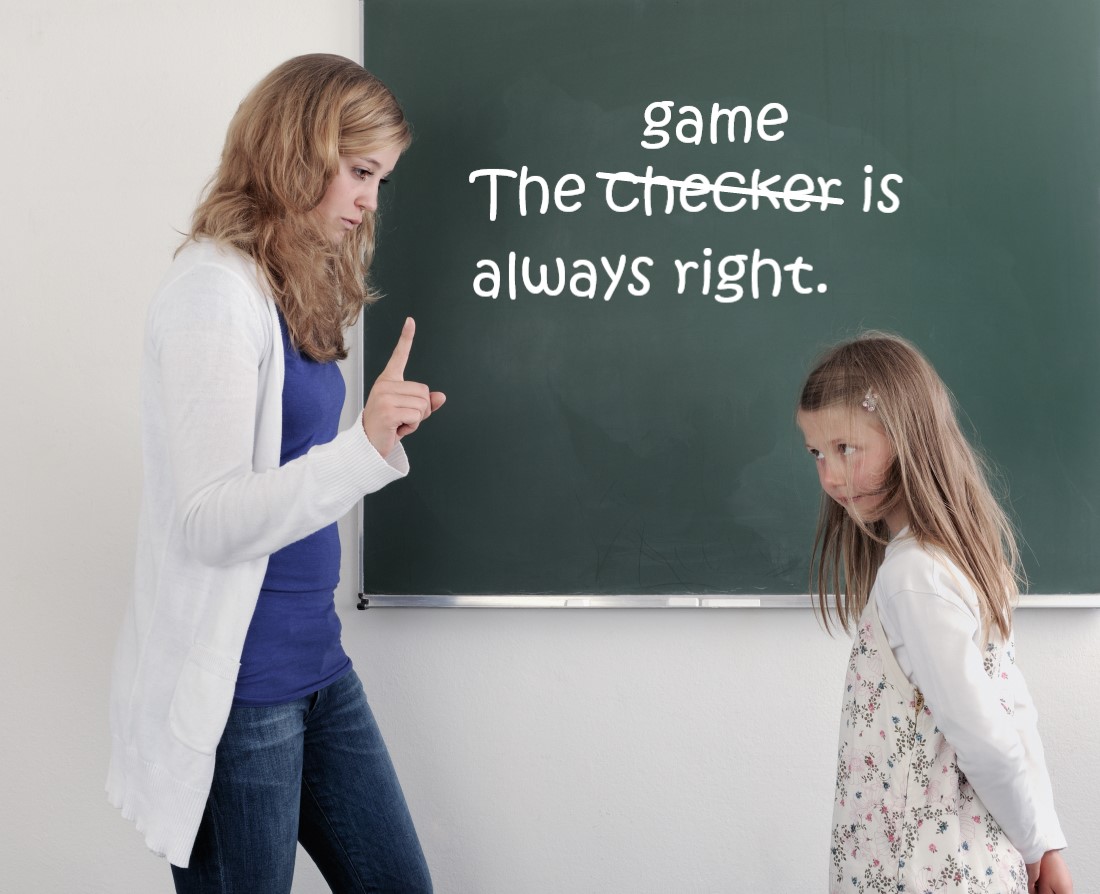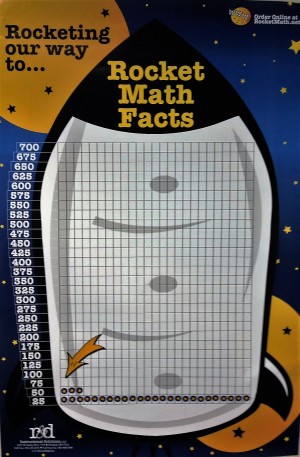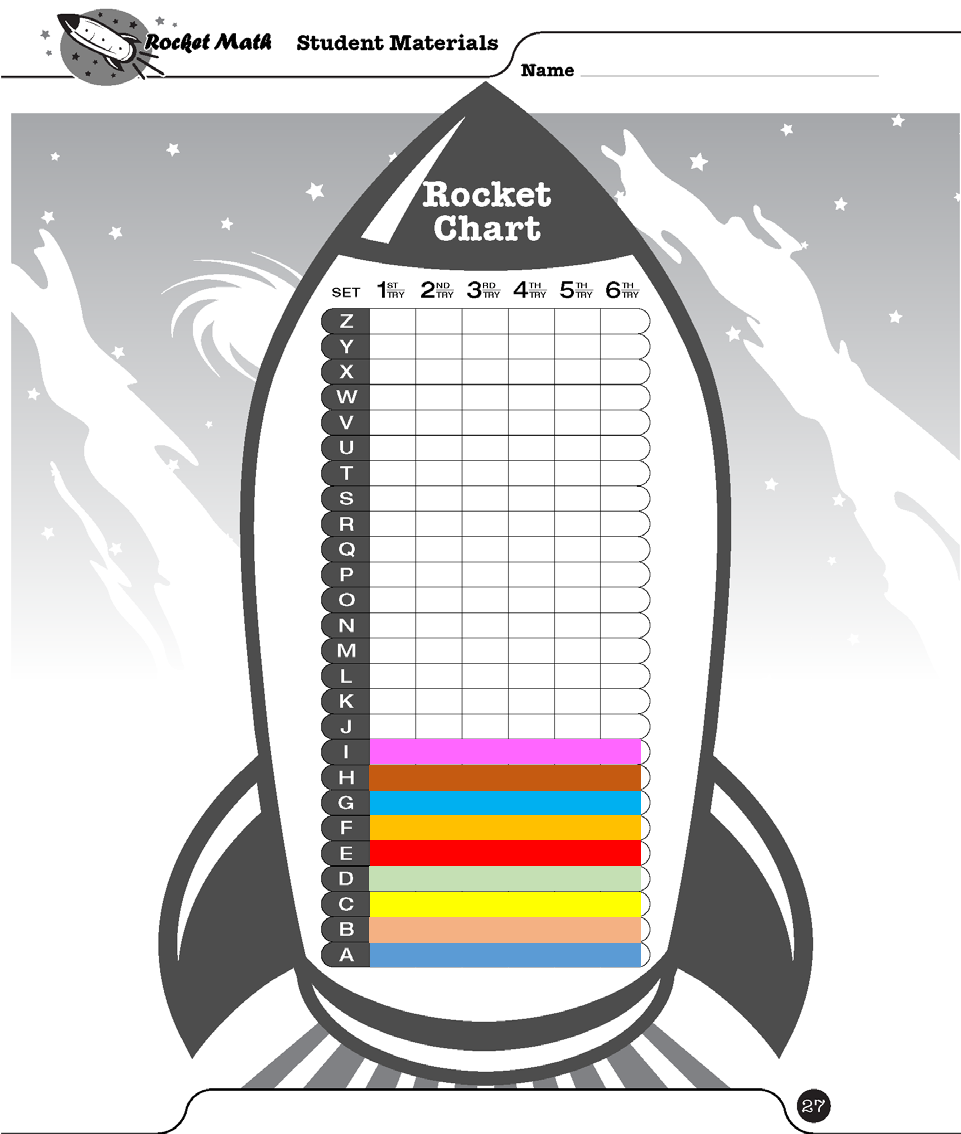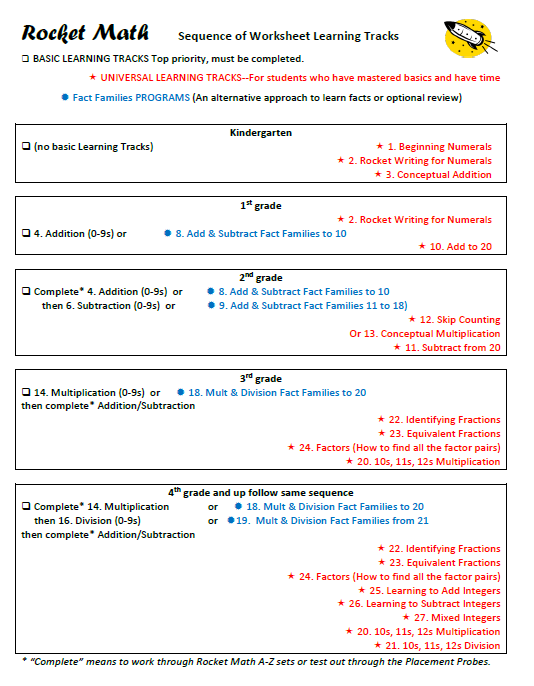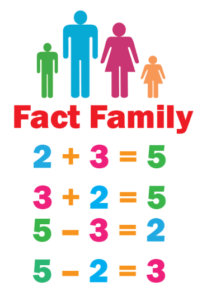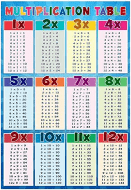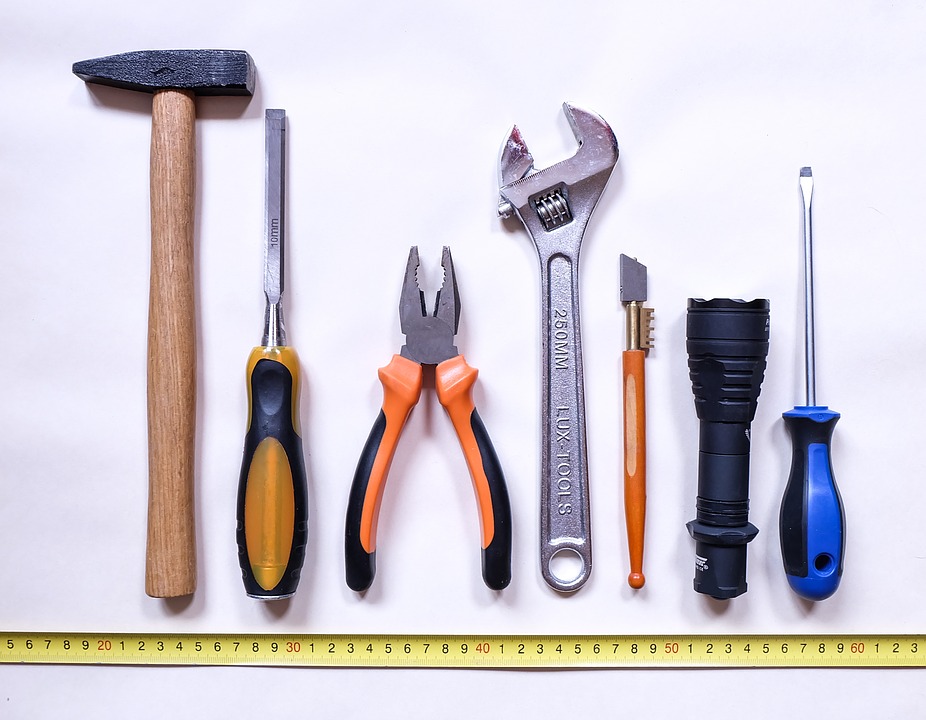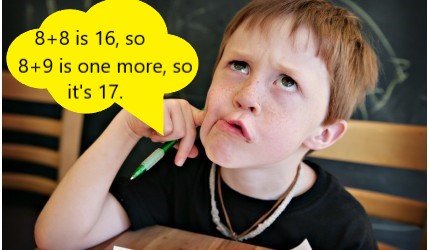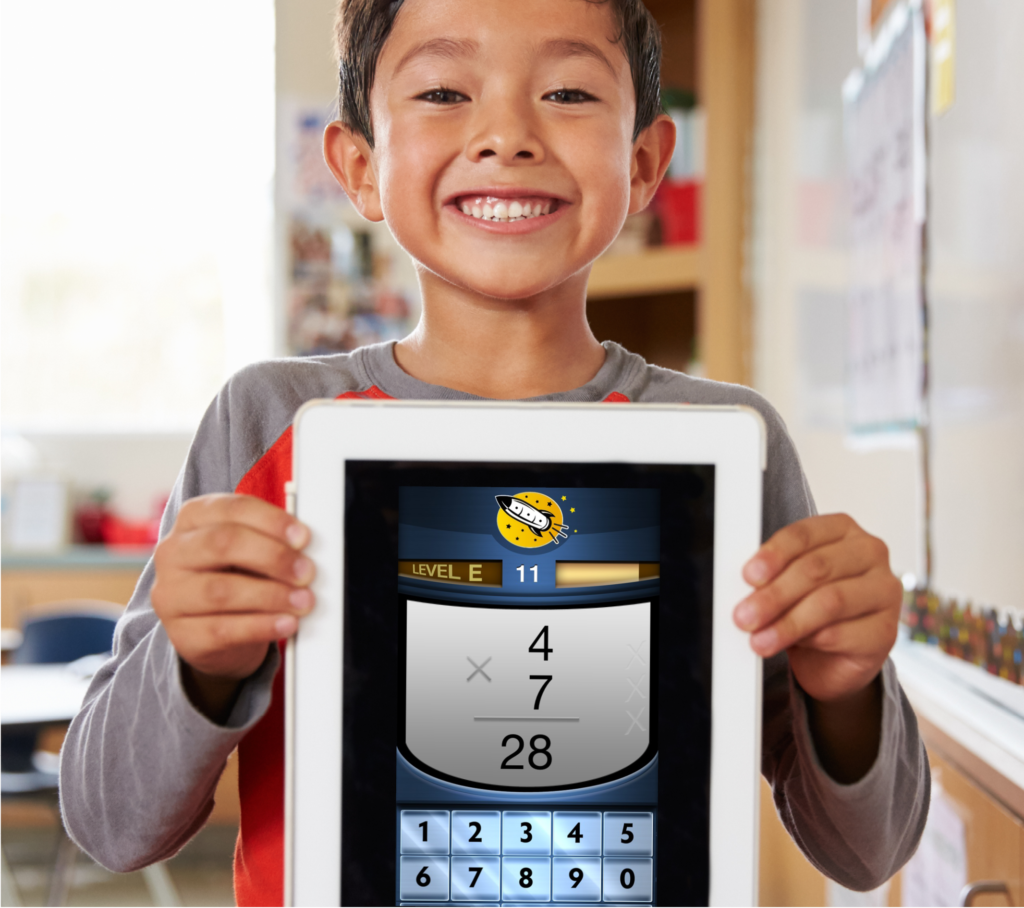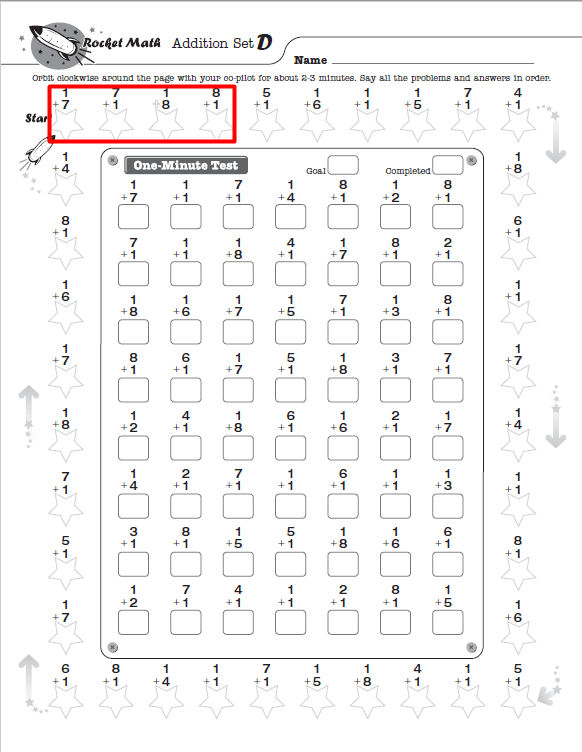Evaluating a Rocket Math implementation when you aren’t observing Rocket Math in action.
Most of the time when you go into classrooms, something other than Rocket Math® will be going on. These are the things you can check on even when there are no students in the room. There are eight indicators you can see by looking at student folders. There are four indicators while looking at the Rocket Math filing crate. There are additional indicators to look for if there is a Wall Chart being used or if there are Race for the Stars games in the room. Here’s a link to the checklist.
Look at several Student Folders
 (1). Students all have folders that appear to be used daily. The folders are the heart of the organizational system. Students should keep their materials in the folders and keep track of their progress on the folders. Whether the students keep folders in their desks, cubbies, or are collected each day, there should be some signs of wear and tear.
(1). Students all have folders that appear to be used daily. The folders are the heart of the organizational system. Students should keep their materials in the folders and keep track of their progress on the folders. Whether the students keep folders in their desks, cubbies, or are collected each day, there should be some signs of wear and tear.
(2). Rocket Charts on student folders show dates of each attempt to pass a level. Each day when students take a 1-minute timing test to try to pass a set of facts, they should write the date of the “try” on the Rocket Chart on the front of their folder. Without this record you cannot tell if a student is stuck because he or she has missed two weeks of school, or if students are only doing Rocket Math® twice a week (not recommended!), or if a student has exceeded six tries without intervention.
(3). Rocket Charts on student folders are colored in when passed. Coloring in the row on the Rocket Chart for the fact set that was just passed is the primary reinforcer of all that hard work. It is essential that students are given the time (and the colored pens, pencils, or crayons) to celebrate their success. Don’t get fooled by the older students or the students who are “too cool” to color in the chart. Even if they only want to color in the row with their regular pencil, students need to be told that they have accomplished something important, and giving them the time to color in their chart is a critical component of the program. This is way more important than you might think. You can also praise students who have accomplished a lot or who have just passed a level. Hearing from an administrator or coach about progress in math facts sends a huge message regarding the importance of the task.
(4). Student folders include packets of answer keys on colored paper. In order to practice correctly, each student’s partner needs to have an answer key in front of them when practicing. Each student needs their own answer key packet (so they can practice with someone who doesn’t have that answer key or with a volunteer who has no answer key). All the answer sheets for their operation should be copied and stapled into a booklet so students don’t have to go hunting for answer keys. Having the answer keys copied onto a distinctive color is important for teachers to be able to monitor paired practice. When students are practicing, each pair should have one student with answers (in that distinctive color) and the partner without the answers (on white paper). Any variation of this means the students are not practicing correctly—and that should be easy for the teacher to spot. Additionally, if a teacher is ready to begin testing and sees a hot pink paper on a desk, the teacher knows someone has answers in front of him or her.
(5) Student folders have the next sheet ready before starting practice time. Some system needs to be put in place so that the limited amount of time available for students to practice is NOT taken up with all students trooping up to the crate to get the next practice sheet each day. The recommended system in the Teacher Directions is to refill student folders when they pass a level, after school, with a packet of six sheets. That way the only time teachers have to handle folders is when students pass and they check the “pass” for errors and refill with a new packet. Many other ways of refilling student folders are possible, but no matter the process, students should have a blank practice sheet or set of practice sheets in their folder—which you would see when you check folders.
(6). Students have clear goals indicated on goal sheet. After students complete the Writing Speed Test, they are to have goals set for their daily 1-minute timing. The goal sheet should be stapled to the inside left of the student folder, the goal line circled, and the 1-minute goal written at the bottom of the sheet. The goal may be crossed out and a higher goal written in if the student has consistently demonstrated the ability to write faster than the original goal. Sometimes, teachers also write the goal on the front on the Rocket Chart, but the student’s goal should be clearly indicated. If not, it may be arbitrary or inappropriate (the same for all students, for example).
(7). Individual graphs are filled in because 2-minute timings are happening. Every week or two, students should be taking the 2-minute timings. These timings are a progress monitoring measure. They could be used for RTI or for IEP goals, or for any other time when a curriculum-based measurement is useful. At least they can demonstrate to us (and to the students) whether they are making progress in learning math facts in a given operation. As students learn more and more facts in the operation to a level of fluency and automaticity, they will be able to write answers to more facts in the operation on the 2-minute timing. Each time they take a 2-minute test, they should count the number correct and graph that on the graph stapled on the inside right of their folder. Each test is graphed in the correct column for whichever week of the month the test was taken.
(8). Individual graphs show upward trends as students are learning facts. Once students are taking the 2-minute timings regularly, it should be easy to see a trend. It should be going up, even if somewhat unevenly. For example, scores might go down after the long December break, but they should recover after a couple of weeks. If these graphs do NOT show an upward trend, something is wrong. Practice may not be being done for long enough (less than 2 minutes a day), or frequently enough (only three times a week), or students may not be practicing correctly (not fixing hesitations and errors). If only one or two students have flat graphs, those students will need something more. The individual graphs will be your indication that there is something amiss. You will just have to figure out what could be wrong. This should lead you to do some observations during Rocket Math® practice in that classroom.
Look at the Rocket Math file crate
 (1). There is a crate or set of files for each operation practiced in the room. Each operation fills a crate and requires a different set of files. In any classroom where not all students are working on the same operation, there will need to be more than one set of files. Sometimes, teachers who have only one or two students in an operation may use the files of a neighbor teacher, but that should be only a temporary fix. The rule is that there must be a crate for every operation being practiced in that class.
(1). There is a crate or set of files for each operation practiced in the room. Each operation fills a crate and requires a different set of files. In any classroom where not all students are working on the same operation, there will need to be more than one set of files. Sometimes, teachers who have only one or two students in an operation may use the files of a neighbor teacher, but that should be only a temporary fix. The rule is that there must be a crate for every operation being practiced in that class.
(2). Rocket Math® crate is filled and organized from A–Z, complete with tabs. As of the 2013 version of Rocket Math®, every operation goes up to the letter Z. So each crate should have hanging folders with tabs showing the letters A though Z. Tabs are important to save time finding sheets and filling folders. If the files are a mess, out of order, no labels, or some letters are empty, valuable practice time will be used up trying to find the right sheets. If everything is labeled, and there are sheets in each file, then efficiency is a possibility. The Rocket Math store has tabs for sale if you need them.
(3). Rocket Math® crate has 2-minute timings numbered 1–5. In order to make sure that teachers do the 2-minute timing and monitor progress readily, they need to have class sets of the 2-minute timings (1 through 5) available in the crate. This is easy for you to check. If they are not there, it is likely that the 2-minute timings won’t be done as regularly as they should be. It is important for those timings to be done so you can see if all the students are making good progress.
(4). Teacher has a hard copy of the directions available for reference. The best place to keep the directions is right in the crate, so they are handy at any time. We have found that most of the time, when teachers are not doing things as they should in their Rocket Math® implementations, they don’t have a copy of the directions. When teachers don’t have the directions handy, they will ask a colleague how to do things. Unfortunately, this is like a game of telephone and typically doesn’t end well. Being sure that every teacher has the directions available for easy reference goes a long way toward proper implementation. It also allows you to pick up the directions when you are in the room and point something out to the teacher or to reference an appropriate page number in the directions in your notes to the teacher.
 You can print the Teacher Directions from the virtual filing cabinet, in the Forms and Information drawer, under Rocket Math Teacher Directions. You can buy printed copies from RocketMath.com/shop. There are additional things to look for on the form but they are optional and go with supplemental parts of the curriculum.
You can print the Teacher Directions from the virtual filing cabinet, in the Forms and Information drawer, under Rocket Math Teacher Directions. You can buy printed copies from RocketMath.com/shop. There are additional things to look for on the form but they are optional and go with supplemental parts of the curriculum.










